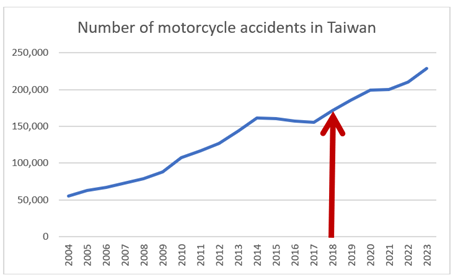Sustainability & CSR
Attention: Turning vehicle!
Mandatory auditory turning alarms are an annoying form of noise pollution and may be ineffective as a way to reduce accidents. Authorities should consider some good alternatives.
By Bart Linssen

Based on my knowledge and casual inquiry, Taiwan is the only country where regulations mandate that trucks and buses emit a beeping sound when turning. This article aims to explore the reasons behind these beeping sounds, history, and necessity.
Why do vehicles in Taiwan have an audible turning alarm?
If you live near an intersection in Taiwan, you will have noticed that trucks and buses emit a beeping sound when turning. The regulation that requires the use of these devices was first implemented only for sand trucks and large tow trucks on 1 January 2002. Initially, other vehicles were not required to have an audible warning device for turning. However, this changed on 1 January 2018, when the regulation was extended to include all trucks of over 3.5 tons and buses.
The regulation specifies that the audible signal must meet the following criteria: At a position of 1.5 metres outside of the alarm lamp and 1 metre above ground, the alarm sound level must be between 75 dBA and 95 dBA. The alarm sound must be intermittent, matching the frequency of the direction indicator/lamp.
Nuisance
The new regulation has negatively impacted the quality of life for those living near busy intersections. An online search of past news articles reveals numerous complaints about the incessant sound of these turning devices.
95 dB is approximately the sound level that these warning devices on most of the vehicles emit and this is as loud as a jack hammer at 15 meters. For those living near intersections, these warning beeps can be heard around the clock, seven days a week. The sound can very well be heard even on the highest floors of apartment buildings with the windows shut.
Particularly disturbing in the recent past have been the turning signals that continuously repeat phrases like “Be careful, car is going to turn” in Chinese. Those signals are not in line with regulations. Due to complaints by residents, the Ministry of Transportation and Communications (MOTC) has recently been enforcing proper adherence to the regulation, allowing only signals that comply with the specified criteria, i.e. alarms should beep.
The MOTC does permit drivers to override the audible signal when waiting at a traffic light to avoid unnecessary disturbance, but this hardly provides any relief, as most vehicles still beep incessantly while waiting for a traffic light to turn green.
Effectiveness
Regarding the effectiveness of audible turn signal warnings, I was unable to find relevant supporting research online. Obviously, the measure aims to address the risk of accidents caused by motorcycles being in the blind spots of trucks or buses.
Based on that objective, we would expect a reduction or at least a slowing of the increase in accidents following the mandate for 3.5-ton trucks and buses to have audible turning signals. However, as shown in the graph below, there was no obvious reduction in the number of motorcycle accidents in 2018, the year the device was mandated for all vehicles weighing over 3.5 tons. On the contrary, the number of motorcycle accidents actually began to increase in 2018.

Figure 1: Number of motorcycle accidents per year in Taiwan
While every life saved is invaluable, and it is definitely commendable that efforts are being made to prevent these accidents, there is just no conclusive evidence to confirm the effectiveness of audible signals. Detailed statistics and further research on the topic seem to be lacking.
Research conducted in the Netherlands, which has a high number of bicycles leading to traffic situations somewhat similar to those seen in Taiwan, indicates that accidents involving traffic participants in the blind spots of vehicles are often due to complicated traffic situations, distractions, and the inability to see where the driver of the large vehicle is turning. Taiwan’s traffic has ample complicated traffic situations and distractions. If complicated traffic situations and distractions are also the basis of most of the accidents in Taiwan, audible warnings may not be effective as a preventive measure.
The same Dutch research shows that accidents happen in particular when the truck or bus wants to turn right and the motorcyclist wants to go straight. At the time of the accident the truck driver did not see the cyclist and the cyclist was not aware that the truck wanted to turn right. Most of the accidents happen in the city in the situation where the truck is waiting for a traffic light. Research shows that in that particular situation, rather than in a driving situation, the driver is more prone to lose sight of any cyclists around them.
The research further shows that 98% of cyclists are aware of the existence of blind spots around vehicles and 88% say that they keep cars’ blind spots in mind, but many do not know exactly where these blind spots are. Many cyclists stop right in the blind spot of trucks while waiting for a traffic light, 33.3% choose the most dangerous position, next to the cabin of the truck.
If you have ever ridden a motorcycle in Taiwan, you will have experienced the overwhelming number of visual and auditory signals in city traffic which make it difficult to notice any particular audible warning, like the ones emitted by a turning bus or truck. Therefore, these warnings seem to make a minimal contribution to motorcycle safety. There is even a possibility that such audible warnings could result in more accidents, as motorcyclists may not heed them, and bus and truck drivers might become less cautious, relying instead on the warnings to alert other traffic participants. To ensure safety, it is best for motorcyclists to stay clear of large vehicles like trucks and buses in general and stay out of their blind spots, and it is essential for truck and bus drivers to proceed with caution and maintain situational awareness while driving.
Potential alternatives
Is the audible warning the best option to prevent motorcycle accidents due to turning traffic? Auditory alarms could potentially worsen the situation if large vehicle drivers rely on them to warn others and the signal is not actually noticed by the other traffic participants due to overwhelming other auditory and visual signals.
Taiwan news reports state that motorcycle accident-related deaths constitute 64% of all traffic-related deaths in Taiwan, with most accidents attributed to driver faults. Taiwan's 30-day traffic-related deaths per 100,000 inhabitants in terms of two-wheelers in 2020 was 7.72, much higher than the 1.69 in the US, 1.34 in South Korea, and 0.47 in Japan. So, there is definitely a need for action, but since, to my knowledge, there is no detailed classification or explanation of the causes of these accidents it may be difficult to define the appropriate measure.
An obvious area of attention, frequently highlighted by the media, is the ease with which a light motorcycle license is obtained. To obtain your motorcycle license, it is sufficient to pass a theoretical test and successfully complete a course. Possibly additional emphasis on situational awareness, checking rearview mirrors, and understanding the blind spots of trucks and buses as well as practice drives in actual traffic may help to raise awareness of the risk of blind spots and reduce accidents.
Casual observation of traffic will also show you that turning signals are not always given by traffic participants, and vehicles turn or change lanes without signaling. This may also be an area for supplementary education or police enforcement.
In addition to training, to enhance safety, we should consider leveraging technology. The large number of motorcycle participants is a unique challenge in Taiwan. The primary issue is the blind spots of buses and trucks, as illustrated in the accompanying picture.

Figure 2: Do you know where the blind spots of a truck or bus are?
None of the searches on the internet on blind spot safety devices suggest technology that uses loud auditory warnings while turning, instead here is a pick of what is suggested:
Blaze Laserlights – These laserlights can be mounted on bikes and motorcycles and will show their presence to the driver of the large vehicle. These lights could be mandated for every motorcycle and bicycle.
Blind spot information systems like Journeo BSIS, Mobileye Shield+ or Servision BSIS alert the driver and camera imagery of traffic participants present in the blind spot of the vehicle, allowing the driver to take the necessary precautions. These systems could be mandated for trucks and buses.
Finally, some bus and truck designers have come up with low entry cabs, greatly enhancing visibility for drivers. Mercedes Econic and Scania L-series and the Foxtron Model T city bus are examples of low-entry cabs, designed specifically for the urban environment. A good alternative then would be to mandate low entry cabs.
In conclusion, there are ample and possibly more effective alternatives to prevent accidents related to vehicle blind spots than adding an auditory warning. Auditory warnings are a nuisance to residents and add to the overwhelming number of audible and visual signals that we already receive while we navigate Taiwan’s traffic; let’s opt for quiet but effective alternatives instead!
Bart Linssen is the Director of Renewable Energy at RCI Engineering.